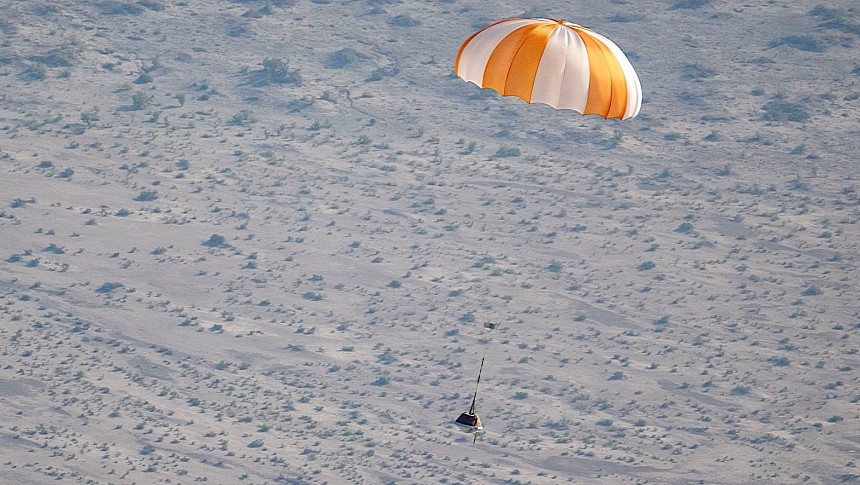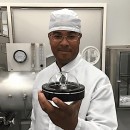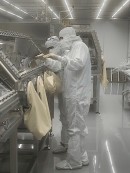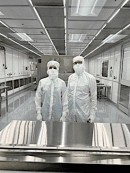It's been a long time coming, but we are now less than four weeks away from an unprecedented moment in human history: the landing of a piece of a very distant asteroid somewhere in the Utah desert. That's right, landing.
It was in 2016 when humanity launched into space a piece of hardware called Origins, Spectral Interpretation, Resource Identification, and Security–Regolith Explorer. Simply called OSIRIS-Rex, the spaceship headed out on a trip 1.4 billion miles (2.25 billion km) long, with a simple mission in mind: snatch a piece of an asteroid and bring it back home for study.
The asteroid is called Bennu, and OSIRIS met up with it in 2018. Over the next three years, it took its sweet time circling the rock and picking from its surface a tiny amount of regolith (at most 250 grams/8.8 ounces).
Then, in 2021 the spacecraft set course for home, and it is expected to reach us on September 24. Or at least that's when OSIRIS will drop a capsule containing the precious asteroid samples down from orbit.
It all looks pretty straightforward: the ship arrives, drops a capsule, the capsule lands and it's recovered. But do keep in mind this is an over $1 billion mission, so NASA is not taking any chances.
For a while now the space agency has been rehearsing the recovery procedure in the Utah desert, where the pieces of Bennu are expected to arrive. The most recent exercise involved a mockup of the OSIRIS capsule being dropped from an airplane, and the rehearsal of the flurry of activity the actual arrival will cause. This was, according to NASA, "the mission’s final major test prior to arrival of the actual capsule."
If you plan on keeping you eye out for this historic moment, NASA will of course run a full live coverage of the event from the Utah Test and Training Range starting at 10 AM EDT on September 24.
The samples being brought back by the mission may prove invaluable for our understanding of the solar system and our place in it. Bennu is 4.5 billion years old, making it a potential prime helper in our quest to understand how organic material was transported to our planet and eventually turned into life as we know it.
Once the asteroid sample safely on the ground, it will be transported to a new curation facility at the Johnson Space Center in Houston. The regolith will then be broken into smaller pieces and made available to about 200 scientists from all over the world.
After it will drop the sample OSIRIS will be repurposed and renamed OSIRIS-APEX. Its new mission will be to head out once more, this time in search of asteroid Apophis, one of the most dangerous pieces of space rocks that we know of.
The asteroid is called Bennu, and OSIRIS met up with it in 2018. Over the next three years, it took its sweet time circling the rock and picking from its surface a tiny amount of regolith (at most 250 grams/8.8 ounces).
Then, in 2021 the spacecraft set course for home, and it is expected to reach us on September 24. Or at least that's when OSIRIS will drop a capsule containing the precious asteroid samples down from orbit.
It all looks pretty straightforward: the ship arrives, drops a capsule, the capsule lands and it's recovered. But do keep in mind this is an over $1 billion mission, so NASA is not taking any chances.
For a while now the space agency has been rehearsing the recovery procedure in the Utah desert, where the pieces of Bennu are expected to arrive. The most recent exercise involved a mockup of the OSIRIS capsule being dropped from an airplane, and the rehearsal of the flurry of activity the actual arrival will cause. This was, according to NASA, "the mission’s final major test prior to arrival of the actual capsule."
If you plan on keeping you eye out for this historic moment, NASA will of course run a full live coverage of the event from the Utah Test and Training Range starting at 10 AM EDT on September 24.
The samples being brought back by the mission may prove invaluable for our understanding of the solar system and our place in it. Bennu is 4.5 billion years old, making it a potential prime helper in our quest to understand how organic material was transported to our planet and eventually turned into life as we know it.
Once the asteroid sample safely on the ground, it will be transported to a new curation facility at the Johnson Space Center in Houston. The regolith will then be broken into smaller pieces and made available to about 200 scientists from all over the world.
After it will drop the sample OSIRIS will be repurposed and renamed OSIRIS-APEX. Its new mission will be to head out once more, this time in search of asteroid Apophis, one of the most dangerous pieces of space rocks that we know of.










